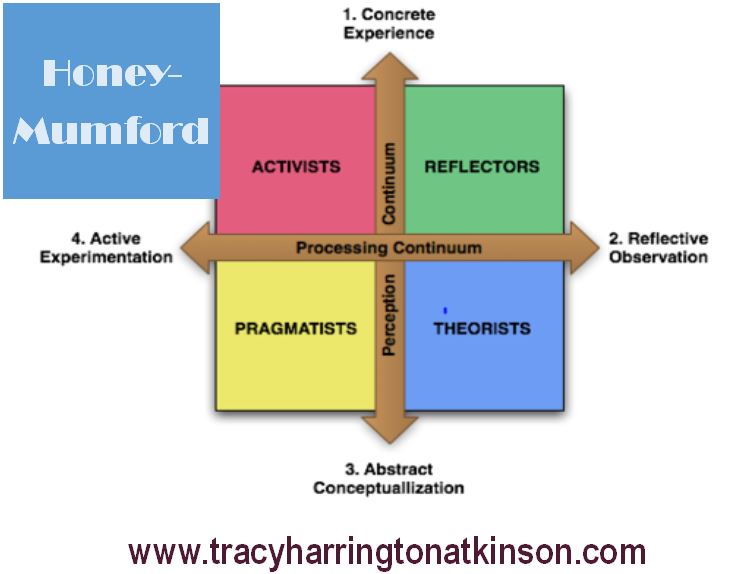Honey-Mumford – 1982
During the 1970s Peter Honey and Alan Mumford studied and expanded upon David Kolb’s learning model. Honey and Mumford proposed that individuals needed to use one of four different learning styles in order to complete activities. These four styles include: activists, reflectors, pragmatists and theorists.
The activist learns by doing rather than seeing, reading or even listening. They seek out challenges and prefer to be working on hands-on problem solving. They will avoid repetition and even planning, preferring brainstorming and finding novel, new ideas to solve dilemmas.
A reflector is a learner who observes. This type of learner will reflect on what is occurring around them. They will avoid confrontation and watch from the sidelines A reflector collects as much information as possible prior to making a choice. Generally, they are seen as being “slow to make up their minds” (Pritchard, 2009, p44).
In contrast, a theorist prefers to adapt and integrate observations and collections of data. The theorist builds upon models, theories, concepts and facts to learn. These learners are uncomfortable with ambiguity and confusion. Order surrounds this learner.
Pragmatists enjoy experimenting with new information, theory and even techniques. They desire to see if something will work. They consistently “Look for the practical implications of new ideas or theories before making a judgement on their value” (Pritchard, 2009, p44). Unlike theorists, pragmatists have little use for theory and abstract ideas unless there is a practical use.
There exists a strong correlation between the Kolb and Honey-Mumford theories. The four learning styles of the Honey-Mumford theory is similar to the Kolb results:
Activist – Accommodating
Reflector – Diverging
Theorist – Assimilating
Pragmatist – Converging
“Our description of the stages in the learning cycle originated from the work of David Kolb. Kolb uses different words to describe the stages of the learning cycle and four learning styles. … The similarities between his model and ours are greater than the differences” (Honey, P. & Mumford, A., 1992).
Honey-Mumford Learning Style Inventory
Honey-Mumford created a learning style inventory to assist in the identification on the dominant learning style. The inventory consists of eighty statements, requiring a yes/no answer. The scores are tallied and plotted on a chart. A mature learner should have a pattern of a kite although not all learners will have balanced results (Pritchard, 2009).
Strengths of each Style
Activist:
- Flexible and open-minded. Happy to have a go.
- Happy to be exposed to new situations.
- Optimistic about anything new and therefore unlikely to resist change.
Reflector:
- Thorough and methodical.
- Good at listening to others and assimilating information.
- Rarely jump to conclusions.
Theorist:
- Logical ‘vertical’ thinkers.
- Rational and objective.
- Good at asking probing questions.
- Disciplined approach.
Pragmatist:
- Keen to test things out in practice.
- Practical, down to earth, realistic.
- Businesslike – get straight to the point.
- Technique oriented.
(Honey, P. & Mumford, A., 1992).
Weaknesses of each Style
Activist:
- Tendency to take the immediately obvious action without thinking.
- Often take unnecessary risks.
- Tendency to do too much themselves and hog the limelight.
- Rush into action without sufficient preparation.
- Get bored with implementation or consolidation.
Reflector:
- Tendency to hold back from direct participation.
- Slow to make up their minds and reach a decision.
- Tendency to be too cautious and not take enough risks.
- Not assertive – they aren’t particularly forthcoming.
Theorist:
- Restricted in lateral thinking.
- Low tolerance for uncertainty, disorder and ambiguity.
- Intolerant of anything subjective or intuitive.
- Full of ‘shoulds, oughts and musts’.
Pragmatist:
- Keen to test things out in practice.
- Practical, down to earth, realistic.
- Businesslike – get straight to the point.
- Technique oriented.
(Honey, P. & Mumford, A., 1992).
Sources:
Alves, P., Miranda, L., Morais, C. & Alves, E. (2012). Proposal of a Learning Styles Identification Tool for Saka Virtual Learning Environment. Computer Science and Engineering. Retrieved from http://article.sapub.org/10.5923.j.computer.20120001.07.html#Ref
Honey, P. & Mumford, A. (1992). The Manual of Learning Styles. Peter Honey Publications; 3rd edition.
Pritchard, A. (2009). Ways of learning: Learning theories and learning styles in the classroom (2nd ed.). New York, NY:Routledge.
Tracy Atkinson, mother of six, lives in the Midwest with her husband and spirited long-haired miniature dachshunds. She is a teacher, having taught elementary school to higher education, holding degrees in elementary education and a master’s in higher education. Her passion is researching, studying and investigating the attributes related to self-directed learners and learning styles. She has published several titles, including MBTI Learning Styles: A Practical Approach, The Art of Learning Journals, Calais: The Annals of the Hidden, Lemosa: The Annals of the Hidden, Book Two, Rachel’s 8 and Securing Your Tent. She is currently working on a non-fiction text exploring the attributes of self-directed learners: The Five Characteristics of Self-directed Learners.




Comments are closed